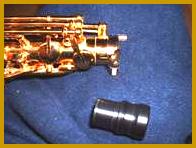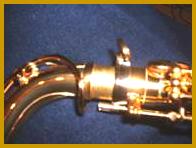

|
SaxophoneMan.com |

|
All Things Saxophone |
|
Equipment Fundamentals — Saxophone Care |
|
Last modified 09/12/08
|
|
Questions or comments? Send us an email |

|
The saxophone is a marvelous, intricate, and delicate instrument. To keep your saxophone in good working order, practice the maintenance techniques below. · Neck joint The saxophone comes in two parts—the body and the neck. They of course must be assembled. This seems simple but you would be amazed at how many students I have seen butcher a horn by not putting these two pieces together correctly. Proper insertion of the neck joint will keep both ends of the joint "true" and reduce the possibility of damaging the neck or octave key. Keep the joints clean and free of dirt & oil. If they are dirty, wipe them clean with a clean soft cloth. NEVER PUT KEY OIL OR CORK GREASE ON THE NECK JOINT -- it just allows dirt to collect there which can cause scratching/scoring on the inside of the joints. To attach the neck to the body, loosen the screw on the neck joint of the body if it isn’t loose already (it should be loose when the sax is in the case).
Then remove the plug from the neck joint on the body.
Next, put the joints together so they just start fitting.
After that, carefully rotate the neck back and forth just a few degrees in each direction -- gravity should cause the neck to ease down into place. NEVER FORCEFULLY PULL DOWN OR UP ON THE NECK -- this could damage the neck and/or the body joint. Now tighten the screw until it is snug - don't over-tighten. To remove the neck from the body, FIRST LOOSEN THE SCREW. Then carefully rotate the neck back and forth (as done for attaching the neck), pulling up LIGHTLY as you go. Be sure to ALWAYS put the neck joint plug back into place on the body when storing the sax in the case. It is not necessary to tighten the screw for the neck plug. · Keys As you use your saxophone the screws on the keys may become loose. Make sure that you have a small set of regular screwdrivers so you can tighten up a screw when it loosens up. Be prompt about doing this -- if you wait too long you may experience the joy of keys falling off your horn in the middle of a chorus of “Have You Met Miss Jones” — right at the bridge :> Keys occasionally need oiling. Key oil is readily available at music stores and online, and valve oil can be used as a substitute. Don't use any other kind of oil. Also, DON'T over oil the keys -- it just spills key oil on your horn and the oil collects more dirt. Get an oil container with a good dispenser so you can apply oil right to the point of need. A good rule of thumb for applying oil is the old cliché: "The squeaky wheel always gets the grease". If a key is not clunky or bound up in its movement, then it doesn't need oil. If a key gets bent, your best bet is to take it to the shop for repair, unless you are properly trained in instrument repair yourself. · Springs What are springs? Springs are metal strips or pins that keep the tension on the keys to either hold the keypad in the up or down position. If a spring slips out of its catch, the key will stop returning to its default position. Usually the spring can be pulled back into position without having to take the horn in for repair. Take a pair of needle-nose pliers and pull the spring back until it snaps into the catch. Springs may lose their tension over time or if they get bent. If this happens or the spring breaks, then its time to take the horn to the repair shop. · Cork and felt spacers The saxophone has many cork and felt spacers -- their position and purpose varies with make and model. They have two main purposes -- to keep keys from directly striking the body of the saxophone (preventing dents, scratches and "klunking sounds), and assisting in placement of keys for proper mechanical operation. If a cork or felt spacer is damaged or falls off, the horn will make klunking sounds and may not operate correctly. Usually you can spot a damaged cork/felt. If you see one, take the horn in and have it repaired. · Neck cork At the end of the neck piece there is cork wrapped around for applying the mouthpiece. This cork should be free from damage and properly greased. Cork grease is readily available at music stores and online, and usually comes in a chap-stick like container. DON'T APPLY ANYTHING BUT CORK GREASE TO THE NECK CORK. To apply cork grease just spread a SMALL amount on the neck cork and use your fingers to spread it around the whole cork. Don't add too much grease -- it will just get pushed off when you put on the mouthpiece and be wasted. · Dents & scratches Always be careful, but do recognize that your horn WILL get dents and scratches. Most dents and scratches have no affect on the horn (I have played some great sounding saxophones that looked terrible). However, a really bad dent can affect the horn's playing, especially if it is high up on the body of the horn (or even worse—on the neck), or if it alters a key position or otherwise interferes with proper mechanical operation. If you encounter such a dent, take it to the shop and have it repaired. DON'T TRY TO FIX A DENT YOURSELF UNLESS YOU ARE PROPERLY TRAINED. Doing so will likely damage the horn further. · Temperature & humidity A saxophone is marginally sensitive to changes in temperature and humidity compared to other instruments like wood clarinets (sensitive) or violins (VERY SENSITIVE). However, it's not a good idea to leave the horn in the car on a winter's night or leave it in the direct summer sun. And of course keep it out of the rain, shower, & the sauna :> This is particularly important for you aspiring saxophonists that are in pep bands or marching bands or otherwise playing outside. You’ve got this great new Cannonball, Yamaha, Keilwerth, Selmer, or whatever, and now you’re going to take it out on the marching field? I DON’T THINK SO!! This would be a great way to DESTROY a very nice horn. If you still have your old student model horn, use that for the football games and the parades. If you don’t have one, get one, or use one of the school’s instruments. It’s better to take the old Chevy out on the dirt roads than the new Cadillac. Keep these maintenance practices in place and your saxophone will serve you well for a long time. — even a lifetime. |
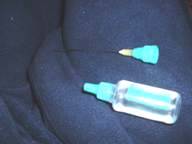
|
Select a key oil container with a good dispenser |
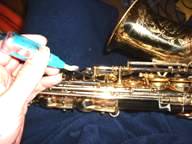
|
Dispense oil sparingly only to the point where needed |

|
Cork and felt spacers are in various places on your horn |
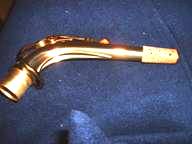
|
Neck cork should be free from damage |
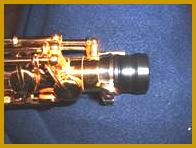
|
Neck plug & screw |
